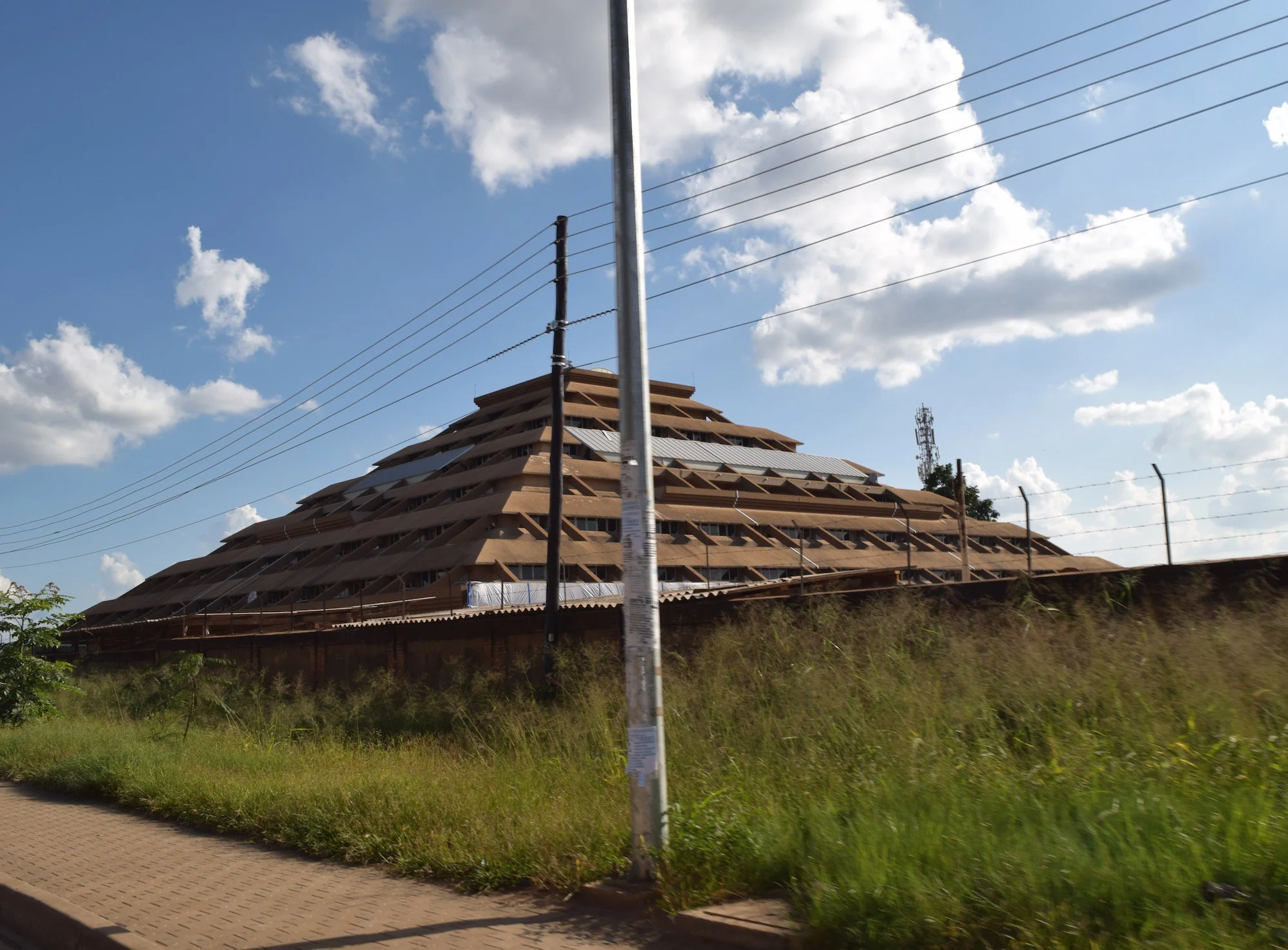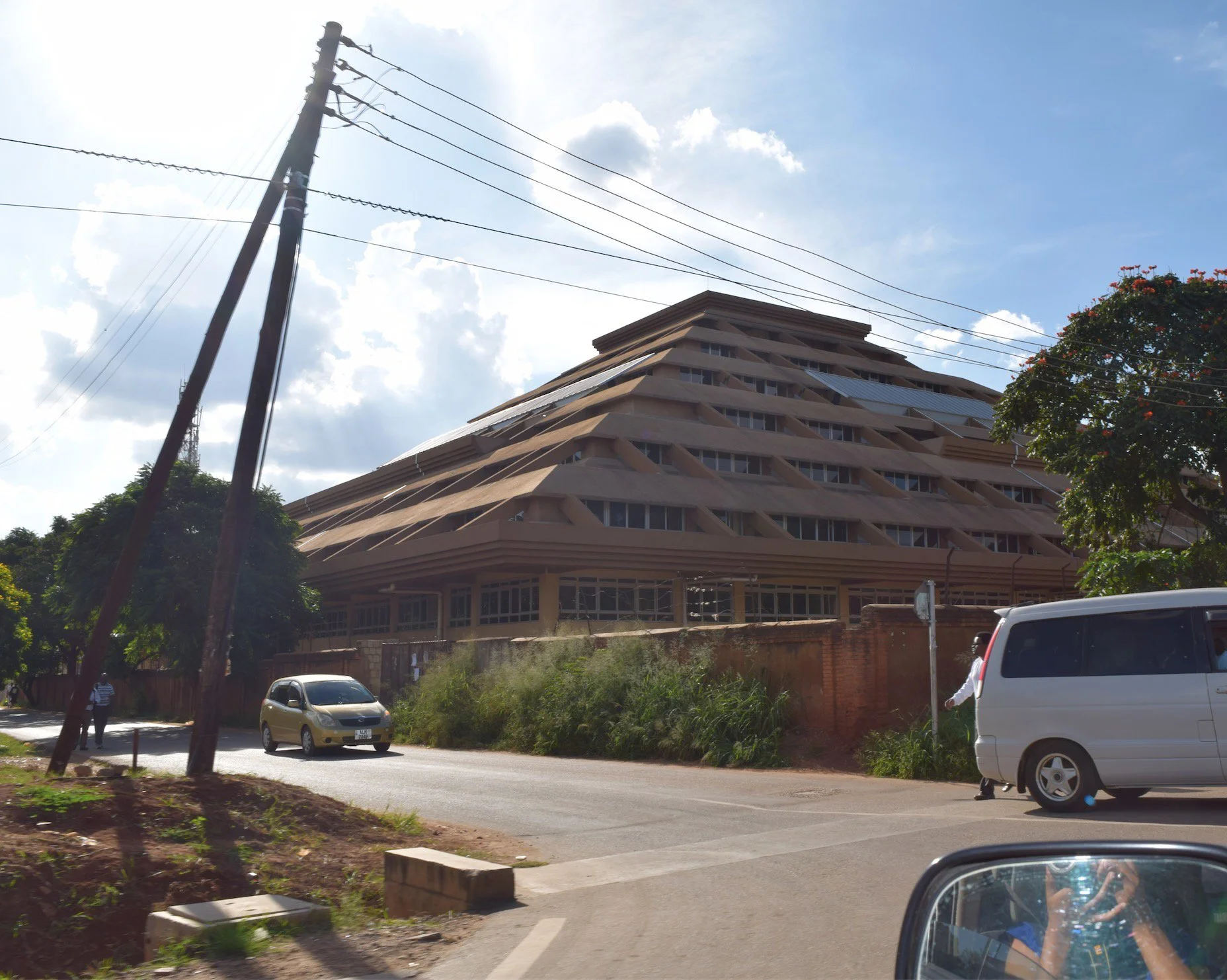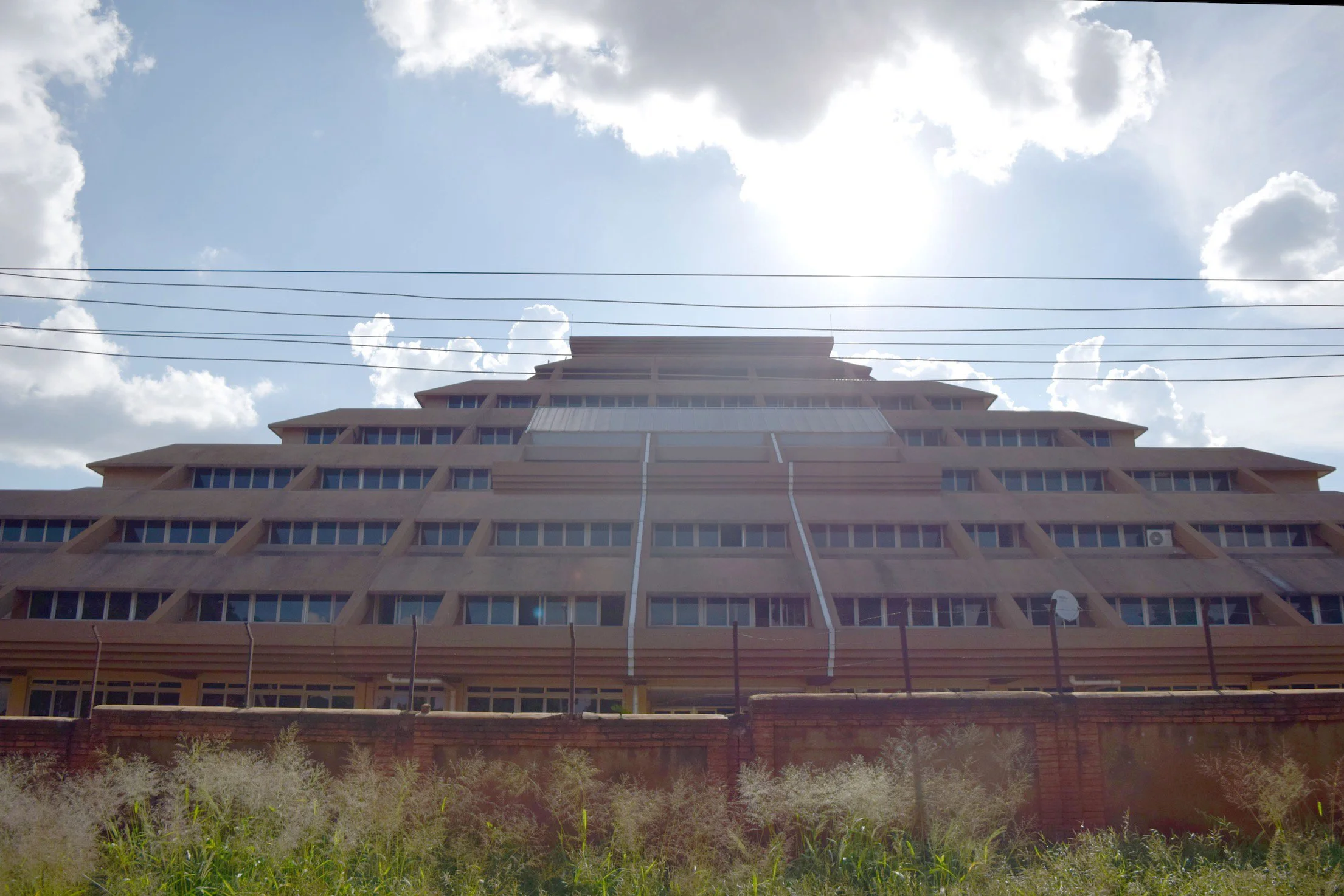
An encounter
with King Zhou’s
pyramid
By Thandi Loewenson
1 July 2020
Equal parts fanfic, research log, and view from the passenger seat of a Toyota Spacio. Here, as in most pyramid schemes, a great amount has been borrowed from others on the promise of some future pay out – some tangible and material, some rumoured, one seen once in a dream. Debts are owed to Liu Cixin and his text The Three Body Problem.
In this epic, devoured in the Crisis Period of a pandemic, the surprising occurrence of a pyramid in an online VR game might just illuminate an alien civilisation’s desire to colonise Earth. Debts are owed too to Paul Mumbi, taxi driver, research contributor and friend, from whose window I first caught sight of the Zambia Statistics Agency: a building so evocative of the institution’s logo, a bar chart of exponential growth with the golden eagle of Independence flying overhead. The chance passing of this similarly other-wordly structure (to say nothing of the promised growth to which it alludes) was just one moment of several years of research into the existence and emancipatory potential of a kind of Weird which finds itself itself particularly at home, and particularly empowered, in Southern Africa.

It was the 21st of March, 2018 when Paul and I encountered King Zhou’s pyramid. I hadn’t remembered putting on the V-suit, but as is often the case with so-called field work, the boundary between politics, research and vision had become vague (as had that between researcher and taxi driver). Or perhaps it was that one or the other dimensions had ossified and, in its hardening growth, been overwhelmed by the others. The garment was doing its work and allowed us both to experience the world of Three Body totally. Paul was driving the second favourite of his fleet of taxis, a blue Toyota Spacio, and the radio gently held the air between our separate bodies of thought, allowing us to drift whilst still sharing the space. That day, we had taken a new route back to town from Chunga, a decision I never fully interrogated, not least because of the sudden, spectacular lurching into view of the roadside palace.
It was a hot day and the photographs that I hastily fumbled to snap attest to this. I look at them now and my skin prickles at the memory. The Sun was so bright that it produced that furious quality of light which almost entirely burns shadows and colour from an image: a glowing, anticipatory white so rare irl yet which pervades our digital realm. The edges of a few clouds are evident, and an intrepid area of blue is made possible by their wake. Then and now, moments like this catch me off guard, as if our efforts to predict the onset of the Chaotic Eras were always futile. Perhaps these periods, beset by a seeming endlessness of struggle, would constantly catch us unaware. At times, we would welcome them and the opportunities offered by a rupturing of a stability which only ever served a few. At others, we would come to realise that chaos of an altogether malign character had just crept in – through the cracks in the mortar and like a fine mould in a dark corner – so much so, that we would be in several years deep before we had even realised. A lay history of King Zhou’s pyramid speaks to the attempts of previous generations to influence the slide from stability to chaos with any degree of accuracy, and now this new incarnation of the structure–
Copernicus sighed. Neither Paul nor I had noticed him appear in the backseat of the car and I remember being distinctly annoyed. Not only would this increase the fare, but it was increasingly impossible to draw your own conclusions without the legacy of some supposedly canonical figure kicking the back of your seat with a point of clarification or conclusions drawn from an era of thought entirely ill suited to theorising the present. Beside him was King Wen’s trunk. I could hear the subtle whistle of sand falling through the chambers of the time piece. It would soon be time to flip it for the second of the three oscillations used to mark a day. A frustrating but necessary requirement given the unreliability of light to hold to fixed hours.
I was grateful that we were in the car. This had happened before at Nando’s and Copernicus’ 16th Century hair style and robes had caused much mirth at my expense. I was also grateful for his Sentinels, despite the way in which they captured earth through a politics of surveillance and the European control of these tools. Flying in orbit overhead, they allowed us to scour for physical remnants of the previous incarnations of the pyramid, and to understand that it had only been growing in this form for thirty years.
In a previous Stable Era, King Zhou’s pyramid had been formed of stone slabs of incrementally receding size, mounted atop one another to form an almost entirely solid thermal mass. The ruler had ordered that fields of giant Magnetite pendulums be built around the palace and kept in constant motion by groups of chanting soldiers. It was believed that the gentle swinging of the mass would lull the Sun into a calm and repenting state thus staving off the onset of a Chaotic Era. No pendulums remain, but Copernicus and I go back and forth. The fiery red earth which can be seen for miles betrays a high iron content and I am certain this is a legacy of their disintegration and leaching into the soil. Much like the darkness of the ground near Kabwe’s Broken Hill, only 100km North, where nearly a century of the most rapacious extraction have rendered the soil a powdery, blackened mass, the orbital eye of the Sentinels reveals a scale of chaos that we might struggle to grasp on foot and by hand. Copernicus sighed again. We were talking about instruments for Solar encounter and here I was, again, more interested in earth.
The trunk was flipped and there was a distinct change in the pitch of the whistle as the holes of the timepiece were hit by the full weight of the sand in its chambers. It caused significant interference to the radio and when I turned back to face the backseat after adjusting the dials, I noticed Confucius now sat where Copernicus had been. He was, at first, bewildered by the sight of the pyramid. Much as I was, by the sight of him.
It appeared to him as if it shouldn’t be. Or rather, shouldn’t be here. Weird. In one notable incarnation in the Warring States Period, King Zhou’s pyramid was formed of a sequence of flat stepped slabs. The erratic onset and retreat of heat and cold had weathered the stone in dramatic and surprising ways, and the palace no longer functioned as a chamber for a ruling class to take cover. Her point was garotted and had been replaced with a machine of elaborate gears and controls and topped with a copper sphere measuring 2 metres in diameter. She now served as a platform for the elaborate performance of a vigilant watch: the pinkish gold surface of the orb attuned to capture the first hint of light signalling the end of a long period of harsh struggle. ‘Kwacha!’ shouted Kaunda, ‘ngwee!’ returned the crowd.
Looking back at my photographs – and I only managed to snap three before King Zhou’s palace vanished from sight – I wonder if I let Confucius hurry us on too quickly. I now know that had it been this incarnation of the pyramid it would have meant that Confucius was soon to meet his demise. Having been so steadfastly committed to an incorrect prediction that the Sun would rise, he stood out in the first blighting cold of a Chaotic Era peering up into the sky waiting for rays that would not appear. Game logs reveal that in some corners of the internet he is still frozen in a block of ice in this very position. Instead, we sped on to the University of Zambia for him to attend, spectrally, the opening of a new campus building in his name.
In the eons of Stable Eras to come and go, King Zhou’s palace would see further change, transmogrifying into new forms, comprising new materials and playing host to new leaders too. Here, on the corner of Nationalist and Paul Banda Road, Zhou’s pyramid is not too dissimilar to the incarnation that Confucius would have recognised. Each step is now accompanied by a band of windows, cleverly inset from the overhang of the concrete to shade the interior from an unpredictable heat. Air conditioning units have been added and a satellite dish clings to a first floor balcony. The roughness of the stone has been rendered and painted ochre, and a string of white gutters and downpipes snake around the soffits to the ground. A wall several metres high makes it impossible to see what has become of the entrance to the great chamber, previously sealed off with a large stone when I had witnessed it last. I am told that what was once the royal residence, has now become a central statistics office. Gone is the copper sphere and its hunger for a glint of light cast from below, and while the coordinated rumble of the pendulums has long since been ground to a halt, they continue to kick up as dust to an almost imperceptible rhythm. The measurement of the onset of chaos and stability has now become a highly bureaucratic affair, requiring spreadsheets and acronyms, countdowns and ticker tape, conferences and end-of-year reports.
The phone rings and Paul tells a client that he is only ten minutes away, when we all know it will be significantly more, and we continue to speed down Nationalist towards a deadline neither of us will make. Time is elongated here, stretched thin so you can see through to the other side. A pyramid on a Lusaka roadside, built of the simultaneous matter of what has and hasn’t yet been, sits out one Chaotic Era, unphased by the searing inevitability of the one to come.
Thandi Loewenson, with Liu Cixin and Paul Mumbi




